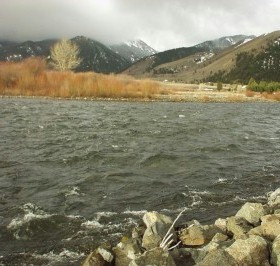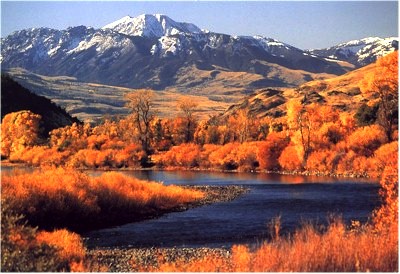The Gallatin River originates in north end of
Yellowstone National Park. The river will traverse
northwesterly for nearly 120 miles through the scenic
Gallatin River canyon and end its journey when it meets
with the
 Missouri.
Widely-known to fly-fishing enthusiast the Gallatin
offers some of best varieties of water for fishing
possible. Missouri.
Widely-known to fly-fishing enthusiast the Gallatin
offers some of best varieties of water for fishing
possible.
The upper Gallatin in Yellowstone begins at about 10,00
feet, gracefully it will meanders it way through
the high alpine meadows. For nearly twenty miles the
river will oxbow the highway that runs north through the
lush Yellowstone meadow. In this section Brown, Rainbow
and Cutthroat trout inhabit the cold waters.
Slowly growing in size. which originates in
Yellowstone Well-known and heavily fished stream that,
regardless of those pitfalls, offers three species of
trout that willingly smack dry flies and nymphs in one
of the most beautiful and rugged portions of the
Treasure State. The Gallatin has 120 miles of appealing
trout water, including a delicate upper portion that
flows through lush meadows, a roily middle section that
cuts through a spectacular, heavily forested mountain
canyon, and a lower stretch that twists across a broad
valley before meeting the Jefferson and Madison rivers
at Three Forks. Lewis and Clark named all three rivers
in July 1805, when the Corps of Discovery reached the
spot where the three forks combine to form the fabled
Missouri River.
In some sections of the Gallatin the estimated number
of mature fish is 4,000 per mile. To say that the Gallatin is fishing well is an understatement. Recent
drought conditions have negatively impacted neighboring streams but according to biologists, the decline in
precipitation raised the Gallatinís water temperatures
to perfect levels for trout growth. Today there are
abundant trout in the Gallatin, with a good percentage
of 12- to 14-inch fish.
streams but according to biologists, the decline in
precipitation raised the Gallatinís water temperatures
to perfect levels for trout growth. Today there are
abundant trout in the Gallatin, with a good percentage
of 12- to 14-inch fish.
In addition to the main river, the Gallatinís
productive tributary streams, such as Fan Creek, Taylor
Fork, and the East Gallatin, are attractive options.
Several productive spring creeks located in the Gallatin
Valley also drain into the East Gallatin. For the
pleasure of fishing Benhart, Thompson, Story, and Smith
creeks, anglers pay a fee.
|